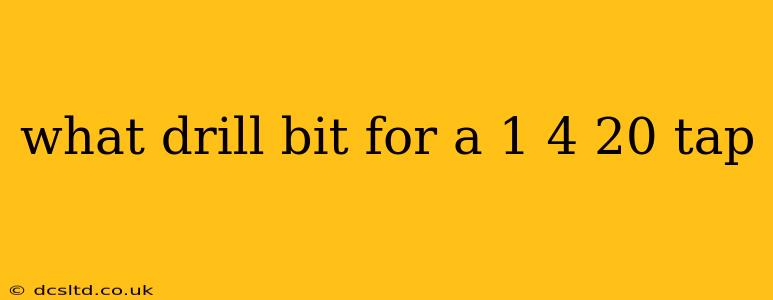What Drill Bit for a 1/4-20 Tap?
Choosing the correct drill bit for tapping a 1/4-20 thread is crucial for ensuring a clean, strong, and accurate thread. Using the wrong size can lead to stripped threads, a broken tap, or a poor-fitting fastener. This guide will clarify the process and answer common questions.
The most important thing to understand is that you don't drill a hole the exact size of the tap. Instead, you need a pilot hole slightly smaller than the tap's minor diameter. The minor diameter refers to the smallest diameter of the threaded portion of the hole. This allows the tap to cut the threads cleanly and prevents binding or breakage.
The generally accepted drill bit size for a 1/4-20 tap is a #7 drill bit. A #7 drill bit has a diameter of 0.201 inches. This size provides sufficient clearance for the tap to engage the material effectively.
However, several factors can influence the ideal drill bit size:
- Material: The material you are tapping into significantly affects the drill bit selection. Harder materials may require a slightly smaller pilot hole to prevent the tap from breaking, while softer materials might allow for a slightly larger hole. Consult a drill bit size chart specifically for your target material for optimal results.
- Tap Type: The type of tap you're using (hand tap, machine tap, etc.) can also subtly influence the ideal drill bit size. Machine taps, for example, often work best with slightly smaller pilot holes.
- Desired Thread Quality: A tighter fit might require a smaller drill bit, leading to a more precise thread, while a slightly larger hole provides easier tapping but potentially less precise threads.
What Size Drill Bit Should I Use for Tapping Different Materials?
The material you're working with significantly influences your drill bit selection. Always consult a tap and drill chart specifically designed for your material for the most accurate results. While #7 is a good starting point for many common metals, using a chart will give you the most precise result.
What is the Difference Between a Tap and a Drill Bit?
A drill bit creates a hole of a specific diameter. A tap, on the other hand, cuts threads into a pre-existing hole, creating the internal threads needed to accept a screw or bolt. The drill bit prepares the hole; the tap creates the threads.
What Happens if I Use the Wrong Drill Bit Size?
Using an incorrectly sized drill bit can lead to several problems:
- Stripped threads: If the hole is too small, the tap may bind and strip the threads, rendering the hole unusable.
- Broken tap: A hole that's too small increases the risk of the tap breaking during the threading process.
- Loose threads: If the hole is too large, the resulting threads will be loose and may not hold the screw or bolt securely.
How Can I Ensure I Choose the Correct Drill Bit?
To ensure accuracy, always consult a tap and drill chart that is specific to the material you are using. These charts provide precise drill bit recommendations for various thread sizes and materials, eliminating guesswork and ensuring optimal results.
By following these guidelines and using a tap and drill chart, you can confidently choose the right drill bit for your 1/4-20 tap and achieve professional-quality results. Remember safety first – always use appropriate safety gear when working with tools.
